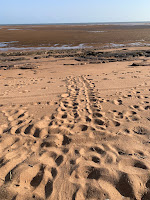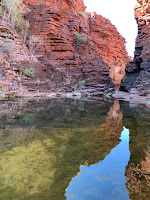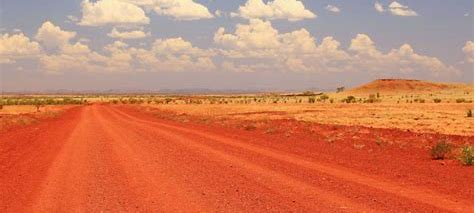It's nearly 7 weeks into our Australian venture, and crikey that time has flown! So much to learn about the complex health system here, with its public, private and Aboriginal providers. Port Hedland is starting to feel a little bit like home, especially as I've spent much of November traveling around WA - Karratha, Perth and inland to Newman, Tom Price, Paraburdoo and Karijini. Peter has been able to come with me (except to Perth), encouraged by my employer, WACHS, as his presence adds to my safety along these challenging roads. Having spent many hours on the roads, I've now got some confidence in driving at 110kph and in overtaking the 60m Road Trains. The drivers flash their right indicators when they can see the way ahead is clear, and this is very reassuring. The roads themselves are fantastic pretty much everywhere - amazing considering the weight of vehicles that travel on them. Maybe the lack of frosts makes a big difference. Understandably, fatigue is a big killer, so having company is definitely a good idea.
Workwise I'm settling in and trying not to be too obviously shocked by the way the health services operate. Lots of good people doing great or amazing things, but overall, a lack of cohesion which leads to pretty stark inequities that seem just too monumental to address. Syphilis is running riot through a number of rural populations (up to 30% of the Hedland population) along with increasing HIV rates. Significant health issues like Diabetes and addictions are increasing birth interventions, as they are elsewhere in the world. And we may be on the brink of another Covid situation, with masks now obligatory for hospital staff.
For rural women of the Pilbara, most of their antenatal care is done by doctors. This means there's hardly any continuity and they often miss out on antenatal education. They're told to move to Hedland (or Birthing Facility of their choice) at 36 weeks pregnant and stay until their baby is at least 5 days old before heading home to their community where health cover may be hit-and-miss. In the small inland town of Paraburdoo, for example, much of the small hospital is de-commissioned (literally, the roof fell in). It's staffed by a single nurse each shift plus one on call, backed up by the Electronic Telehealth Service (ETS) and the Flying Doctor Service (RFDS). A GP practice operates out of a bus in the car park, but this is a private service, and the GP doesn't have any requirement to provide any health cover to the hospital, even in an emergency. The next nearest hospital is in the town of Tom Price (population 3000), about an hour away, itself a further 4.5 hours' drive to the main centre in Hedland. Like most of the smaller hospitals, these are non-birthing units, though of course that doesn't mean they don't have births there from time to time. Some women simply refuse to leave their hometown, or don't have the resources, or leave it too late; others go into preterm labour or have another pregnancy complication and are flown out and away from the support of their family and community. The financial, practical and emotional cost of moving away to birth is enormous. The government provides a fraction of the funding. Post natal care by midwives is anywhere between 5-14 days before handover to Child Health Nurses, and in some places (Hedland included) this is on an outpatient basis, i.e. no home visits. Private systems operate as they choose, as do the Aboriginal Medical Services (AMS) who also have outreach into the Indigenous communities. The service anyone gets totally depends on where they live, who they're employed by or not, and how many $$ they have. It's very different indeed to the (old) UK and NZ maternity provision and relies heavily on spectacular, though often temporary, staff on the ground.
Hedland Maternity (and Special Care Nursery) is 80% staffed by agency midwives, and it's tricky for health services to compete with the financial packages that agencies offer, especially in places that are not so attractive to live in. It's easy to see why midwives would choose a life of contracts rather than being tied to a particular employer and schedule. Even among employed health staff, some are FIFO (Fly-In-Fly-Out) if that's the only way to cover the services. It's an effective strategy used across all sectors, but it does impact on the community vibe when a proportion of residents are only there for work on and off and don't consider it their home.
Phew, good to get that off my chest! I'm keen to record some of these early impressions so I can see if my perspective changes over time or with new information.
Back to home life. We're becoming more familiar with Hedland and have even located a local garden centre and a store that sells a few tropical fish. Next year (getting Christmas out of the way first) I'll be joining the Care for Hedland group, which supports environmental projects like recycling, litter clearing, sea turtle monitoring, reef health, and amazingly their Community Garden. I'll be able to get my gardening fix, just not at home, though I'll have to wait until April for the main growing season.
We joined one of the turtle nesting tours on Cemetery Beach in Port Hedland at high tide one evening. There are scientists involved, but most of the work is done by trained volunteers who monitor the turtle activity twice daily throughout the season. It was dark and even by the small red torch light of the volunteers it took a while for our eyes to adjust. Soon we were treated to the sight of huge (80kg+) Flat Backed Turtles crawling up the beach, digging holes and laying eggs. We had to follow specific etiquette - 'Stop, Drop and Act Like a Rock' - to avoid inadvertently interfering with their activities. The next morning, we took a walk along our local beach at Pretty Pool to see if there were any hatchlings (we'd heard that the season started early so there was a chance). None on this watch alas, but we did see the characteristic sand markings and mounds made by egg-laying females the previous evening (in the photos). Hope to add a hatchling update to this story next blog!
The work trip to Karratha allowed a little time to explore this part of the Pilbara. On the way over we checked out Point Samson, a small and totally charming coastal settlement with beautiful beaches, including Honeymoon Cove in the photo, that we'd love to return to sometime. The enormous mining truck is on display at the entrance to the township of Wickham, between Roebourne and Point Samson (and there are many more at entrances to other mining towns). We also headed north of Karratha to Dampier on the Burrup Peninsula, home of Red Dog. The peninsula is famous for its many Indigenous cave paintings that we'd planned to check out but were thwarted by bush fires on the main highway, necessitating an earlier than planned return home. Next time...
Last week I had a few days in Perth, attending a workshop and meeting other WACHS staff. It was great to meet fellow Midwifery Educator Sian and staff from the Midwifery and Obstetrics Emergency Telehealth Service (MOETS). MOETS has been running for less than 2 years, providing a 24-hour midwifery support service that can beam into any rural site, so particularly vital for the smaller non-birthing health facilities when pregnant women present. They can also access live CTGs from rural birthing units like Hedland and provide expert support for maternity staff in their clinical decision-making. It was good to see this service in action. Socially I managed to catch up, and de-brief (!), with the lovely Melanie over a fantastic dinner at Elizabeth Quay on the Perth waterfront. My old pal Amanda, formerly of Renwick NZ and last seen in the UK in 2019, was also in town. She cycled in with son Alexander and we had a gorgeous evening catching up on old and new times.
We've just returned from a week-long trip inland, primarily for me to do some mapping of rural hospitals but providing a fab opportunity to also check out the region. We drove to Newman first, then headed to Tom Price via Karijini National Park. The road (State Route 136) took us along Karijini Drive, right through the centre of the park. An excellent road as always, meaning that you can drive at 110kph if you want. Our first stop was at a viewpoint/rest area called Albert Tognolini (pics above), where we could look down on the road and landscape and wonder how different it may look in winter and after some rain. We then headed for the Karijini Visitor Centre near Dales Gorge, which has lots of exhibits about the nature, geological and human history of the region. I learned that Aboriginal elders show their respect by calling to the spirits in the land. When they come to a waterhole, they don't help themselves to the water without announcing their presence. They sing out to the country to say who they are and where they have come from. They let the spirits know that they belong there, 'greeting the water' by taking a mouthful and spraying it into the air. How soul-filling is that?
From the centre, we headed into Dales Gorge itself, via the lookout over the gorge. The short walk to Fortescue Falls was made easier by heaps of metal steps before a final descent over the natural rock staircase. It was easy to get right up to the fantastic and cooling waterfalls. Then a short walk through rocky bush to the beautifully lush Fern Pool. Peter spotted a large number of fruit bats in some of the gum trees in the bush, just hanging there keeping cool.
Fern Pool was extremely inviting, but no togs (and other visitors), so no swimming this time, but won't make this mistake again. I did get a tickly pedicure from small nibbly fish (species unknown) when I dangled my hot feet in the refreshing water.
We re-visited Karijini on our way home from Tom Price, this time heading to Joffre Gorge. We chose a fairly short walking route as there was a 4+ hour drive home ahead of us. The route was rated as class 5 (i.e. pretty hazardous) and would have been way more challenging if it had been wet. It was a joyful scramble down a rocky path, over a dry creek bed and then down into the gorge via a series of steep metal ladders. Even at 8am it was already hot, and the metal handrails were nearly unbearable. What a sight awaited us down in the gorge. Beautiful, layered rocks, and a sequence of amazing pools, round or narrow. This time there were no other visitors, so we didn't have to resist having a perfect dip! Wow and wow. What a legend of a magical place.
The drive home took us through more stunning park scenery and different landscapes. It's hard to describe the vastness and unique beauty of the north of Western Australia. In places, it's as if colourful boulders and rocks have been liberally scattered by giants over mountainous and undulating landscapes, sometimes in mounds, sometimes alone, and bound together by a range of vegetation - grasses, shrubs and trees. The colours are essentially white, green, yellow, red and black, against a blue sky, but this doesn't convey the depth of the palette. The white eucalypt bark is gorgeously shiny, almost reflective, and is visible from afar. The greens are many - blue-green, yellow-green, grass-green, spring-green. The yellow of the spinifex grass is a soothing, buttery yellow, similar to autumnal gingko. The red of the rocks and dust from its iron ore content, isn't really red. My mother-in-law would probably have called it 'auburn', and this seems about right to me though the rocks can also be more orange than red. Peter says it's Pantone 201, but I prefer auburn! The black is charcoal from bushfires that are a natural part of the landscape. Some of the charred areas we passed were quite recent occurrences.
Approaching Hedland, the landscape reverts to flat, mangroved and salty zones, and of course the industrial mining infrastructure. It's quite different from inland - the salt works are visible from our balcony, so is pleasantly familiar home territory. There's plenty more to return to Karijini for, and the next trip we'll have both time and togs! We have other holidays planned around the Pilbara too, in our new-to-us vehicle - a Nissan X Trail fully kitted out with camping gear, including (joy of joys!) a roof top tent. We won't camp until the weather is cooler but no reason why we can't get alternative accommodation in the meantime. Maybe a trip to Broome in late December /early January.
There are moments of homesickness that just land without warning, but that's to be expected. Happily, there's plenty to keep us distracted and occupied in this unique land.






































